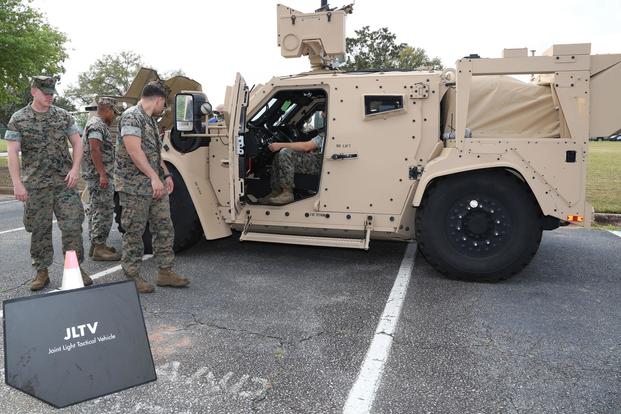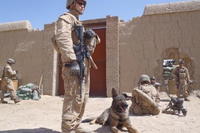A Marine Corps official said Wednesday that many of the Joint Light Tactical Vehicle's reliability and safety shortcomings identified in a Pentagon test report have been fixed and the JLTV is ready for battlefield use.
A recently released Fiscal 2018 Annual Report from the Defense Department's Director, Operational Test and Evaluation was critical of the joint Army and Marine JLTV program, stating that it will not be operationally suitable until officials fix problems ranging from safety issues, such as a lack of situational awareness, to maintenance issues that led to mission failures during tests last year.
But much of the data in the DOT&E report was taken from the Multi-Service Operational Test and Evaluation (MOT&E) that the Army and Marine Corps conducted between February and April last year and does not include the steps the services have taken to address the problems, said Andy Rodgers, program manager for Marine Corps Light Tactical Vehicles.
"The Army and the Marine Corps are both joint partners on the JLTV program, so we are attuned to the issues that come up," Rodgers told defense reporters Wednesday in a roundtable discussion of JLTV fielding in the Corps.
Related content:
- Blind Spots and Loud Noises: Report Finds Problems With New JLTVs
- JLTV Is Tougher and Faster, but Troops Will Still Ride Into Battle on Humvees
- Soldiers Total JLTV Days After Delivery
"It is worth noting that a lot of the items that have been identified in the past couple of days are items that we saw a year ago. ... The test community does not take into account the ... work that has been done since then," he said. "We have shown that we are operationally suitable and effective."
The Corps is scheduled to begin fielding its first 55 JLTVs on Thursday to the Marine School of Infantry-West at Camp Pendleton, California, Rodgers said. After Memorial Day, the service will begin fielding JLTVs to 3rd Battalion, 8th Marines, II Marine Expeditionary Force, at Camp Lejeune, North Carolina. Fielding will continue to I MEF at Pendleton and III MEF in Okinawa, Japan, in September.
By the end of fiscal 2019 in late September, the Corps plans to field between 250 and 300 JLTVs, Rodgers said.
Overall, the service plans to field about 9,091 JLTVs compared to the Army's plans to buy about 49,099 of the vehicles.
The DOT&E report identified safety shortcomings in the JLTV, such as poor visibility because of blind spots.
"Visibility is a subjective statement. I don't have a requirement for something empirical that says a Marine or soldier will have X amount of vision," Rodgers said, adding that the Army is working to increase the size of the rear windows and put a front-facing camera on the vehicle.
"The Marine Corps is a joint partner, and we are keeping tabs on it," he said. "We will take a look and assess it and present [it] to the Marines to see what they want to do."
Crews also experienced slow egress from JLTVs and numerous reliability failures, such as doors not opening, making it difficult for them to get safely in and out of the vehicle, the DOT&E report states.
Rodgers said that minor adjustments have been made to the doors, adding that they have an adjustment system that takes time to understand.
"Through proper training and understanding of the armored door system, it will be much easier for them to operate," he said.
In addition, the Marine Corps has made a point to identify "a second access/egress point" in case a vehicle is involved in a rollover, Rodgers said.
"For the gun trucks, you can go out through the gunner's turret," he said. "For the ... general-purpose variant or the utility variant -- the two-door -- we will have an egress hatch up there also."
The DOT&E report also criticized JLTV maintenance and operator training programs and manuals as inadequate.
In 2012, as the JLTV entered the engineering, manufacturing and development phase, there were "conscious decisions made, because this was at the height of sequestration, that we were going to take, basically, approaches to reduce the cost and save taxpayer dollars," Rodgers said.
One of those approaches was to place less importance on maturing manuals and other logistics products, he explained. It wasn't until after Oshkosh Corp. won the JLTV competition in 2015 that an emphasis was placed on maturing the parts, manuals and training packages, he said.
The initial 40-hour maintenance training package has been replaced by an 80-hour program that was matured and validated last summer, Rodgers said. There's also a new 56-hour operator training package.
"That class has also matured quite a bit due to the fact that we have now completed our operator training manuals and our ... interactive electronic technical manuals," he said.
The DOT&E report was critical of the JLTV's Close Combat Weapons Carrier variant, stating that it was not operationally effective and citing problems such as a complex missile reload process that slowed tube-launched, optically tracked, wire-guided (TOW) missile crews.
Program officials have investigated solutions, such as how to improve the missile reload process.
"So, whether it was the firing procedures for the Close Combat Weapons Carrier -- a lot of those problems can be solved by improved tactics, techniques and procedures, or TTPs," Rodgers said.
"What I believe is, once we start fielding and we are training the maintainers, training the operators and they are more comfortable with the vehicle, the reliability of the vehicle will go up," he said, "which means there will be less maintenance on the vehicle."
-- Matthew Cox can be reached at matthew.cox@military.com.










